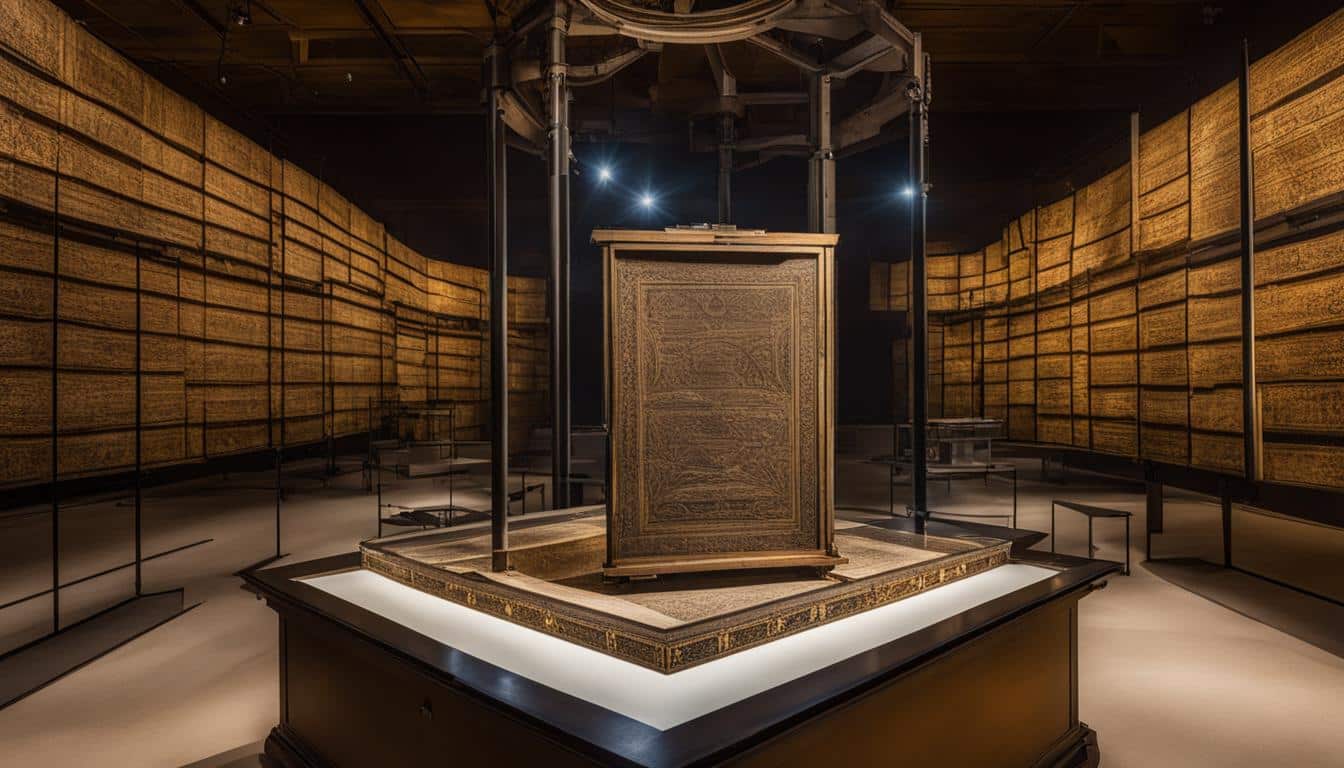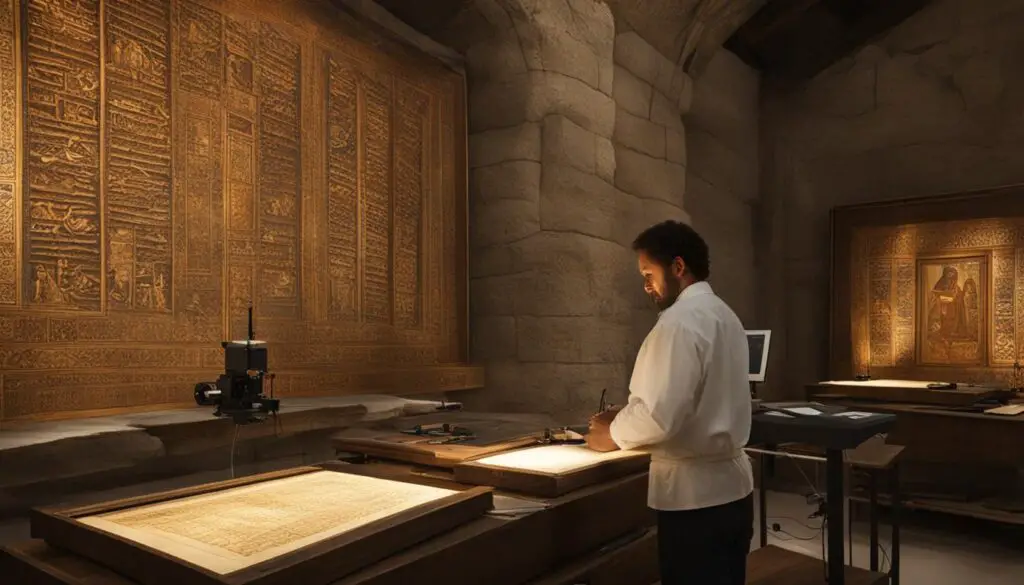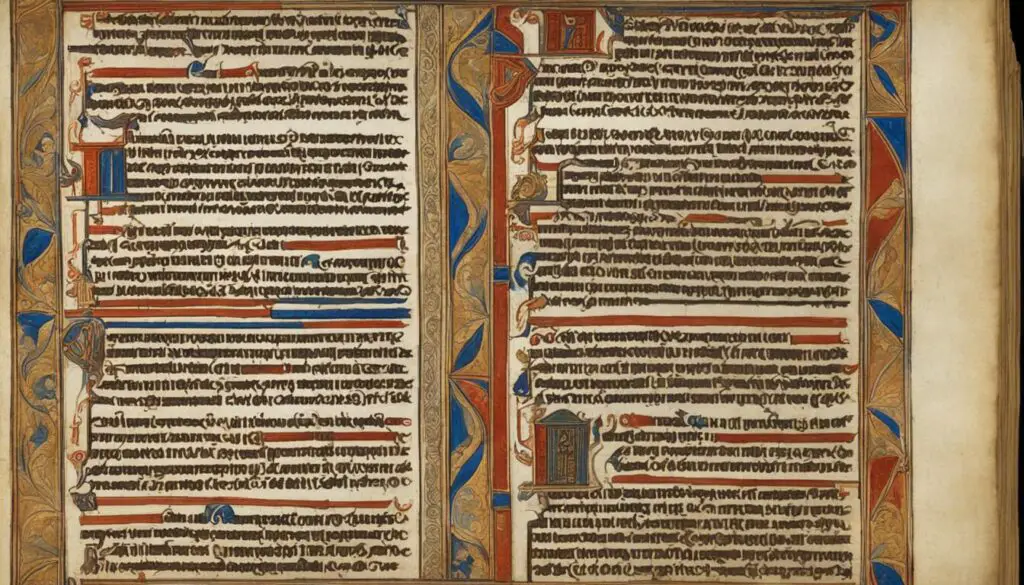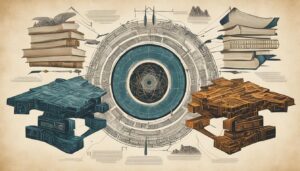
As a professional in the field of biblical manuscript studies, I have witnessed the incredible impact of advanced imaging techniques on the preservation and study of these ancient texts. Through the use of cutting-edge technologies, we are able to capture, analyze, and restore these invaluable artifacts, ensuring their longevity and accessibility for future generations.
The fragile nature of biblical manuscripts, often made from delicate materials like papyrus, parchment, or vellum, poses significant challenges in preserving their integrity. However, advanced imaging techniques offer non-invasive approaches to capture high-resolution images of the manuscripts without causing harm to the originals. This allows scholars and researchers to examine and analyze the texts in detail, unlocking their secrets without risking further deterioration or loss.
Key Takeaways:
- Advanced imaging techniques are revolutionizing the preservation and study of biblical manuscripts.
- These techniques enable scholars to digitally capture, analyze, and restore ancient texts.
- Preservation is crucial due to the fragile nature of biblical manuscripts.
- Non-invasive imaging technologies help preserve the integrity of the manuscripts.
- Advanced imaging techniques provide valuable insights into the content, structure, and history of biblical manuscripts.
The Importance of Preservation
Preservation is paramount when it comes to biblical manuscripts, as these texts are often centuries or even millennia old. The fragile nature of the materials, such as papyrus, parchment, or vellum, makes them susceptible to deterioration, damage, or loss over time. Advanced imaging techniques offer non-invasive approaches to capture high-resolution images of the manuscripts, allowing for detailed examination and analysis without causing harm to the originals.
With the use of advanced imaging technologies, experts can ensure the long-term preservation of these invaluable artifacts. By creating digital copies, the originals can be safeguarded, reducing their exposure to environmental factors that can accelerate deterioration. Through careful imaging and documentation, the content and physical condition of the manuscripts are captured and preserved, ensuring that future generations can study and appreciate these ancient texts.
“Preservation of biblical manuscripts is of the utmost importance. These texts are not just pieces of history; they hold immense cultural and religious significance. It is our responsibility to protect and preserve these fragile artifacts for future generations.”
Preservation efforts not only focus on the physical aspect of the manuscripts but also on the content they contain. By utilizing advanced imaging techniques, experts can uncover previously illegible or hidden text, enabling further study and analysis. These digital images serve as a valuable resource for scholars and researchers, providing a detailed record of the manuscripts’ content and structure.
The preservation of biblical manuscripts ensures that these ancient texts continue to be accessible and readable for generations to come. Through the use of advanced imaging techniques, these priceless artifacts can be safeguarded, providing valuable insights into the religious, cultural, and historical context of the past. By prioritizing preservation, we can protect and honor the legacy of the manuscripts, allowing their profound knowledge to inspire and enlighten present and future generations.
https://www.youtube.com/watch?v=DnrHRcpQD9g
Cutting-Edge Imaging Technologies
Several advanced imaging technologies play a crucial role in the preservation and study of biblical manuscripts. These innovative techniques harness the power of advanced equipment and analysis methods to provide valuable insights into the content, structure, and physical composition of these ancient texts.
Multispectral Imaging
One of the key imaging technologies used in the examination of biblical manuscripts is multispectral imaging. This technique involves capturing the manuscripts under different wavelengths of light, ranging from ultraviolet to infrared. By analyzing the reflected light, multispectral imaging can reveal hidden or faded text that is not visible to the naked eye alone. This non-invasive approach allows scholars to uncover previously unknown or illegible content, providing a deeper understanding of the manuscripts’ context and significance.
Reflectance Transformation Imaging
Another powerful imaging technology employed in biblical manuscript research is reflectance transformation imaging (RTI). RTI involves capturing multiple images of the manuscript from different angles using specialized lighting. These images are then digitally processed to create an interactive representation that allows scholars to manipulate the lighting and examine surface details with enhanced clarity. By studying the manuscript’s texture, brushstrokes, or surface markings, RTI offers valuable insights into the production techniques, artist’s style, or potential hidden features of the biblical manuscripts.
X-ray Imaging and Hyperspectral Imaging
In addition to multispectral imaging and reflectance transformation imaging, X-ray imaging and hyperspectral imaging techniques are also utilized in the study of biblical manuscripts. X-ray imaging can penetrate the materials of the manuscripts, enabling scholars to observe hidden layers, palimpsests, or internal structures without physically disturbing the precious artifacts. Hyperspectral imaging, on the other hand, captures images at various wavelengths with high spectral resolution, providing detailed information about the physical composition and chemical characteristics of the manuscripts. These advanced imaging technologies contribute significantly to the comprehensive analysis and understanding of biblical manuscripts.

Digital Restoration and Analysis
One of the significant advantages of advanced imaging techniques is the ability to digitally restore and analyze biblical manuscripts. Through image processing algorithms, damaged or faded portions of the texts can be enhanced and made legible again. This allows scholars to piece together fragmented texts, decipher illegible script, and undertake detailed textual analysis.
Using state-of-the-art software, digital restoration can improve the legibility and clarity of the manuscript, bringing to light intricate details that were previously obscured. By digitally enhancing the text, researchers can uncover hidden layers of meaning and gain a deeper understanding of the historical context in which the manuscripts were written. These advancements in restoration technology have opened up new avenues for research and interpretation.

Additionally, digital platforms and databases play a crucial role in the organization, storage, and dissemination of digitally restored manuscripts. These platforms provide researchers worldwide with easy access to high-resolution images, enabling collaborative efforts in analyzing and interpreting the texts. Moreover, digital databases facilitate the comparison and cross-referencing of multiple manuscripts, enriching scholarly discussions and advancing our collective knowledge of ancient biblical texts.
“Through digital restoration, we can uncover layers of meaning hidden within these ancient manuscripts, shedding light on their historical and cultural significance.” – Dr. Sarah Johnson, Biblical Studies Scholar
With the aid of digital analysis tools, scholars can undertake comprehensive linguistic and historical investigations. Through computational analysis, patterns and trends can be identified, contributing to a deeper understanding of the language and writing styles employed in biblical texts. By analyzing textual variants and comparing different versions of the same manuscript, researchers can gain insights into the transmission and evolution of the biblical text over time.
The Role of Spectral Imaging
Spectral imaging is a cutting-edge technique used in the digital analysis of biblical manuscripts. By capturing a manuscript under various light wavelengths, spectral imaging reveals hidden or faded text that is otherwise imperceptible to the naked eye. It allows for the identification of different ink compositions, erasures, and corrections within the text, providing invaluable information for scholars studying the manuscript’s origin, authorship, and revisions.
Researchers are continuously refining and developing new algorithms and techniques to improve the accuracy and precision of digital restoration and analysis. The combination of advanced imaging technologies and digital platforms has truly revolutionized the study of biblical manuscripts, opening up new avenues of research and enhancing our understanding of these ancient texts.
| Advantages of Digital Restoration and Analysis: | Challenges in Digital Restoration and Analysis: |
|---|---|
|
|
Conclusion
Advanced imaging techniques have revolutionized the field of biblical manuscript studies, providing scholars with unprecedented access to the content and material aspects of these ancient texts. Through preservation, cutting-edge imaging technologies, and digital restoration, researchers can now delve deeper into these invaluable artifacts, unlocking new insights into religious, cultural, and historical contexts.
By utilizing advanced imaging techniques, scholars can capture high-resolution images of biblical manuscripts without causing any harm to the originals. This allows for detailed examination and analysis, revealing hidden or faded text through multispectral imaging and enhancing surface details through reflectance transformation imaging. Moreover, X-ray imaging and hyperspectral imaging provide valuable insights into the physical composition and structure of these ancient manuscripts.
The ability to digitally restore and analyze biblical manuscripts using advanced imaging techniques is a game-changer for researchers. Image processing algorithms can enhance and make legible the damaged or faded portions of the texts, facilitating the reconstruction and deciphering of fragmented or illegible script. Digital platforms and databases enable efficient organization, storage, and dissemination of these digitized manuscripts to scholars worldwide.
As technology continues to advance, the field of advanced imaging techniques for biblical manuscripts holds immense potential for further discoveries and advancements. The combination of preservation, cutting-edge imaging technologies, and digital restoration allows us to unlock the secrets hidden within these ancient texts, shedding new light on religious, cultural, and historical narratives.
FAQ
What are some advanced imaging techniques used for preserving biblical manuscripts?
Advanced imaging techniques used for preserving biblical manuscripts include multispectral imaging, reflectance transformation imaging, X-ray imaging, and hyperspectral imaging.
How do advanced imaging techniques contribute to the preservation of biblical manuscripts?
Advanced imaging techniques allow for non-invasive capture of high-resolution images of biblical manuscripts, enabling detailed examination and analysis without causing harm to the originals.
What can multispectral imaging reveal in biblical manuscripts?
Multispectral imaging can reveal hidden or faded text in biblical manuscripts by capturing them under different wavelengths of light.
What does reflectance transformation imaging enhance in biblical manuscripts?
Reflectance transformation imaging enhances surface details in biblical manuscripts by combining multiple images taken from different angles.
What insights can X-ray imaging provide in the study of biblical manuscripts?
X-ray imaging can provide valuable insights into the physical composition and structure of biblical manuscripts.
How can advanced imaging techniques digitally restore biblical manuscripts?
Through image processing algorithms, advanced imaging techniques can digitally restore and enhance damaged or faded portions of biblical manuscripts, making them legible again.
How do digital platforms and databases contribute to the study of biblical manuscripts?
Digital platforms and databases enable the efficient organization, storage, and dissemination of digitized biblical manuscripts, providing researchers worldwide with access to these valuable artifacts.
What benefits do advanced imaging techniques bring to the field of biblical manuscript studies?
Advanced imaging techniques revolutionize the field of biblical manuscript studies by offering unprecedented access to the content and material aspects of these ancient texts, unlocking new insights into religious, cultural, and historical contexts.
What is the potential for further advancements in the field of advanced imaging techniques for biblical manuscripts?
As technology continues to advance, there is immense potential for further discoveries and advancements in the field of advanced imaging techniques for biblical manuscripts.








